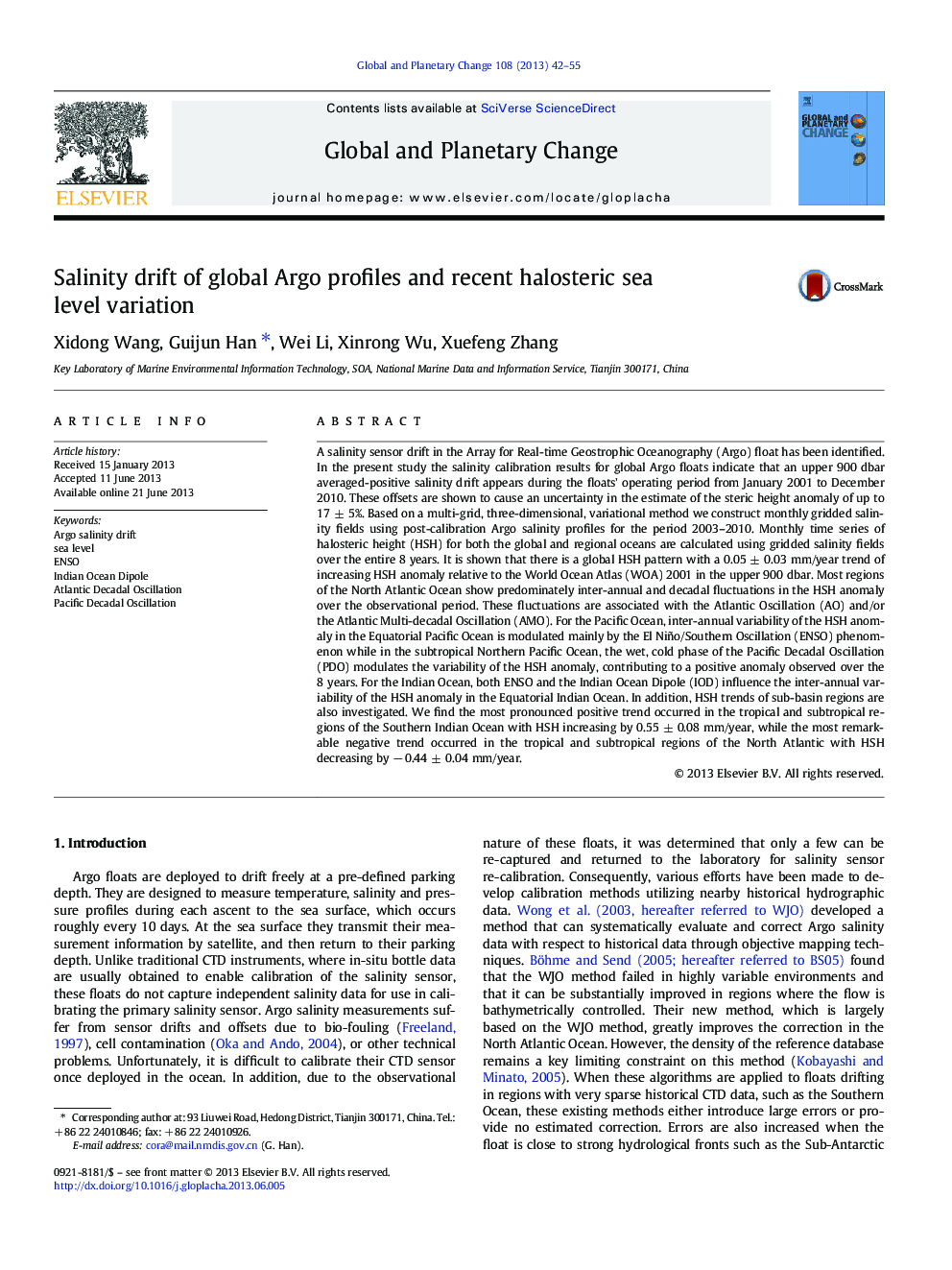| کد مقاله | کد نشریه | سال انتشار | مقاله انگلیسی | نسخه تمام متن |
|---|---|---|---|---|
| 6348254 | 1621673 | 2013 | 14 صفحه PDF | دانلود رایگان |
عنوان انگلیسی مقاله ISI
Salinity drift of global Argo profiles and recent halosteric sea level variation
ترجمه فارسی عنوان
راندگی شوری از پروفایل های جهانی آرگو و تغییرات اخیر سطح هالستریکی دریا
دانلود مقاله + سفارش ترجمه
دانلود مقاله ISI انگلیسی
رایگان برای ایرانیان
کلمات کلیدی
موضوعات مرتبط
مهندسی و علوم پایه
علوم زمین و سیارات
فرآیندهای سطح زمین
چکیده انگلیسی
A salinity sensor drift in the Array for Real-time Geostrophic Oceanography (Argo) float has been identified. In the present study the salinity calibration results for global Argo floats indicate that an upper 900 dbar averaged-positive salinity drift appears during the floats' operating period from January 2001 to December 2010. These offsets are shown to cause an uncertainty in the estimate of the steric height anomaly of up to 17 ± 5%. Based on a multi-grid, three-dimensional, variational method we construct monthly gridded salinity fields using post-calibration Argo salinity profiles for the period 2003-2010. Monthly time series of halosteric height (HSH) for both the global and regional oceans are calculated using gridded salinity fields over the entire 8 years. It is shown that there is a global HSH pattern with a 0.05 ± 0.03 mm/year trend of increasing HSH anomaly relative to the World Ocean Atlas (WOA) 2001 in the upper 900 dbar. Most regions of the North Atlantic Ocean show predominately inter-annual and decadal fluctuations in the HSH anomaly over the observational period. These fluctuations are associated with the Atlantic Oscillation (AO) and/or the Atlantic Multi-decadal Oscillation (AMO). For the Pacific Ocean, inter-annual variability of the HSH anomaly in the Equatorial Pacific Ocean is modulated mainly by the El Niño/Southern Oscillation (ENSO) phenomenon while in the subtropical Northern Pacific Ocean, the wet, cold phase of the Pacific Decadal Oscillation (PDO) modulates the variability of the HSH anomaly, contributing to a positive anomaly observed over the 8 years. For the Indian Ocean, both ENSO and the Indian Ocean Dipole (IOD) influence the inter-annual variability of the HSH anomaly in the Equatorial Indian Ocean. In addition, HSH trends of sub-basin regions are also investigated. We find the most pronounced positive trend occurred in the tropical and subtropical regions of the Southern Indian Ocean with HSH increasing by 0.55 ± 0.08 mm/year, while the most remarkable negative trend occurred in the tropical and subtropical regions of the North Atlantic with HSH decreasing by â 0.44 ± 0.04 mm/year.
ناشر
Database: Elsevier - ScienceDirect (ساینس دایرکت)
Journal: Global and Planetary Change - Volume 108, September 2013, Pages 42-55
Journal: Global and Planetary Change - Volume 108, September 2013, Pages 42-55
نویسندگان
Xidong Wang, Guijun Han, Wei Li, Xinrong Wu, Xuefeng Zhang,
